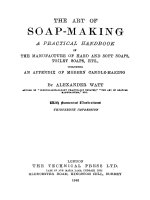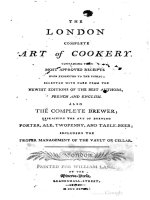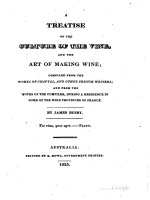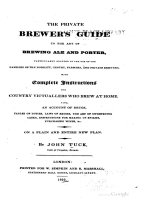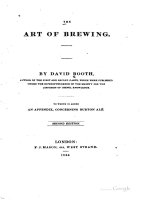Ebook The art of woodworking classic American furniture: Phần 1
Bạn đang xem bản rút gọn của tài liệu. Xem và tải ngay bản đầy đủ của tài liệu tại đây (47.98 MB, 71 trang )
.16* /1
n
J
J
| '.;"-:
_9
xzr
u
l " #
I
I
t
I
I
t
I
THEARTOFWOODWORKING
HOMEWORI$HOP
I
I
I
I
WORKSHO
GPU I D E
HARDWARE
ANDINLAYS
Bed bolt covers
M
Escutcheone
Federal-otyle inlayo
t
I
I
I
I
I
I
I
I
I
I
I
ff:'&[
t
CATCUTATING
BOARD
FEET
NUMBER
OFBOARD
FEET
()F
IN4 TINEAR
FEET
DIFFERENT
SIZEBOARDS
1"x 12"x 12"= 1otandard board foot
1-by-3=lboardfoot
1-by-6=2boardfeet
1-by-12=4boardfeet
2-by-4 = 22/z board feet
2-by-6=4boardfeet
0rdering
lumber
bytheboard
foot
Because
theboardfootisa unitof measurement
that
offersa standard
wayof totaling
thevolume
of stock
regardless
of dimensions,
it is commonly
usedwhen
dealing
withlumber.
Asshownat left,thestandard
boardfootis equivalent
to a piecethatis 1 inchthick,
12 inches
wideand12 inches
long.Tocalculate
the
pieceof wood,
number
of boardfeetin a particular
multiply
itsthreedimensions
together.
Thendivide
theresult
by I44 if thedimensions
areall in inches,
or by 12 if onedimension
is expressed
in feet.Forthe
standard
board,
theformulais:
I " x 7 2 "x 1 2 "+ 1 4 4= I ( o r1 "x 1 2 "x I ' = L 2= 7 ) .
youwouldcalSoif youhadan8-foot-long
1-by-3,
culatetheboardfeetasfollows:
1 x 3 x 8 + 12 = 2 (or
2 boardfeet).Otherexamples
areshownin theillustration.Remember
thatboardfeetarecalculated
on
thebasisof nominal
ratherthanactualsizes.
I
I
I
I
I
I
I
I
I
t
I
I
I
I
I
THEARTOFWOODWORKING
CLNSIC
AMERICAN
FURNTTURE
THE ART OF WOODWORKING
CIASSIC
ANAERICAI
FURNITURE
TIME-LIFE
BOOKS
ALEXANDRIA,
VIRGINIA
ST.REMYPRESS
MONTREAL
r
I
I
I
THE ART OF WOODWORKING was produced by
ST.REMYPRESS
Publisher KennethWinchester
President
/ ChiefExecutiveOfficer FernandLecoq
President/ ChiefOperatingOfficer PierreL6veilld
SeriesEditor
SeriesArt Director
SeniorEditor
Editor
Art Directors
Designers
PierreHome-Douglas
FrancineLemieux
Marc Cassini
Andrew Iones
lean-PierreBourgeois,Michel Gigudre
FrangoisDaxhelet,Jean-GuyDoiron
FrangoisLongp16
PictureEditor ChristopherJackson
Writers fohn Dowling, AdamVan Sertima
Contr ibuting IlIustrators GillesBeauchemin,Michel Blais,
RonaldDurepos,Michael Stockdale,
JamesTh6rien
Administrator NatalieWatanabe
ProductionManager MichelleTurbide
Coordinator DominiqueGagn6
SystemCoordinator Eric Beaulieu
Photographer RobertChartier
Indexer ChristineM. Jacobs
Time-Life Booksis a division of Time Life Inc.,
a wholly owned subsidiaryof
THE TIME INC. BOOK COMPANY
TIME-LIFEINC.
President
andCEO JohnM. Fahey
TIME-LIFEBOOKS
President
ManagingEditor
Directorof Design
Directorof Editorial Operations
JohnD. Hall
RobertaConlan
MichaelHentges
EllenRobling
ConsuhingEditor
Vice-Preside
nt, BookProduction
ProductionManager
Manager
Quality Assurance
fohn R. Sullivan
Marjann Caldwell
MarleneZack
famesKing
THECONSUTIANTS
t
JonArno is a consultant,cabinetmaker,and freelancewriter who
livesin Tioy,Michigan. He conductsseminarson wood identificationand earlyAmericanfurnituredesign,and is the authorof
TheWoodworkers
VisualHandbook,publishedby RodalePress.
I
I
Mike Dunbar builds fine furniture at his workshop in
Portsmouth,New Hampshireand offersWindsorchairmaking
seminarsacrossNorthAmerica.He is a contributingeditorof
AmericanWoodworkerand author of FederalFurniture and
MakeAWndsor ChairWth MichaelDunbar,bothpublished
by The ThuntonPress.
GilesMiller-Mead taught advancedcabinetmakingat Montreal
technicalschoolsfor more than 10years.A nativeof New
Zealand,he hasworked asa restorerof antique furniture.
ClassicAmericanfurniture.
p. cm.- (TheArt of woodworking)
Includesindex.
ISBN0-8094-9542-2
1. Furniture making.I. Time-Life Books.II. Series.
TTl94.C531995
749.213-dc20
95-2t990
CIP
For information about any Time-Life book,
pleasecall I-800-621-7026,or write:
ReaderInformation
Time-Life CustomerService
P.O.BoxC-32068
Richmond,Virginia
2326r-2068
@ 1995Time-LifeBooksInc.
All rights reserved.
No part of this book may be reproducedin any form or by
any electronicor mechanicalmeans,including information
storageand retrievaldevicesor systems,without prior written permissionfrom the publisher,exceptthat brief passages
may be quotedfor reviews.
First printing. Printed in U.S.A.
Publishedsimultaneouslyin Canada.
TIME-LIFE is a trademarkof Time WarnerInc. U.S.A.
R r 0 9 8 7 6 5 4 3 2 r
t
I
I
I
I
t
I
I
t
I
I
I
I
I
I
t
I
I
I
I
t
I
I
I
I
CONTENTS
6 INTRODUCTION
T2 CTASSICAMERICAN
FURNITURE STYLES
22 PEMBROKETABLE
24 Anatomy of a Pembroketable
26 Making the leg-andrail assembly
30 Preparingthe siderails
4 I Making the drawer
43 Making the top
L04 QUEENANNE SECRETARY
106 Anatomy of a
QueenAnne secretary
109 Making the deskunit
1 1 6 Making the drawers
1 1 9 Building the pigeonholeunit
12T Making the fall-front
1 3 0 Making the bookcase
1 3 5 Making the doors
I4O GLOSSARY
I42 INDEX
48
50
52
59
66
FOUR-POSTERBED
Anatomyof a four-posterbed
Tirrning the bedposts
Making the end boards
Pencilposts
70 WINDSOR CHAIR
72 Anatomy of a sack-back
Windsor chair
74 Making the spindles
80 Making the bow and arm
84 Making the seat
88 Making the legs,arm posts,
and stretchers
94 Assemblingthe chair
103 A milk paint finish
I44 ACKNOWTEDGMENTS
INTRODUCTION
Dr. Iohn Kassayon
WINDSOR
FURNITURE
deceptivelywell-engineered
furniturestylewhosepartsareassembled
mainly
fromwoodensticks,
Wndsorrepresents
oneof history's
mostinnovative
and
recognizable
furnituredesigns.
TheWindsorfamilyof furnitureconsists
of stools,
chairs,
cradles,
stands,
andtables.
Chairsarethelargest
categorywith
eightdifferent
basicforms,suchascomb-backs,
step-downs,
andthesack-back
version,
whichis
featured
beginningon page70.Chairsalsospawned
ninederivatives
thatinclude
rockingchairs,
stools,
writingarmchairs,
andchild-sized
chairs.
Theoriginof Wndsorsisancienthistory.Theirantecedents
canbeattributed
to
theEgyptians,
wheretombdrawings
of the18thDynastydepictworkmensittingon
threeJegged
hand-hewn
stoolssocketed
to a plankseat.Thereason
for thename
Wndsoris something
of anenigma,
but themostlogicalexplanation
is thatthey
werenamedduringthefirst decade
of the 18thCenturyaftertheEnglishtown
of Windsotwhosebeechtreesprovideda plentifrrlsupplyof rawmaterialfor legs
andotherturnedparts.
Windsorchairsimprovedon thetraditionaljoiner'schairsof theperiodby
eliminatingtheneedto glue-upseatframes.
In aWindsorchair,theseatis a solid
plankservingasthefoundationfor thelegsandstretchers
andfor thespindleback.
Thatsimplicityandstrenghof designis no doubtoneof thekeysto thechair's
undyingpopularityandlongevity.
Windsorchairmakingstarted
asa cottage
industryin England
duringthe1720s,
but soonbecame
animportantfactory-based
operation,
employing
hundreds
of
workers,
centered
in thetownof HighWycombe.
AlthoughthefirstWndsorsin
Americawerechairsimportedfrom England,Philadelphia
chairmakersalmost
immediately
capitalized
on thispopularnewform of easilymadeseating.
Their
one-manshopsexpanded
intolargefactories.
Englishchairmakerstookadvantage
properties
of thephysical
of differentwoods
for differentcomponents
of thechairs,usingashfor bentparts,beechfor turnings,
andelmfor seats.
TheirAmerican
counterparts
usedhickoryredoakor ashforbending,maplefor turnings,andpinefor seats.
Windsors
weretraditionallypaintedgreen,
butothercolorssuchasblue,mustardandredwerealsoused.Thepaintconcealed
the
differentwoodcolorsandservedto protectthewoodoutdoors,whileconveying
a
unifyingwholeness
to thepiece.ManyEnglishchairsweresimplydip stained.
Nowretired,Dr.JohnKassay
taughtfurnituredesign
for 30yearsat San
Francisco
published
StateUniversity.
HisBookof Shaker
Furniture,
bythe
University
ofMassachussetts
Press,
isconsidered
oneof theforemost
reference
preparing
boolcs
onShaker
style.Heiscurrently
a similarbookonWndsor
publisher.
the
same
He
lives
in SanBruno,Califurnia.
furniturefor
I
r
I
I
r
I
I
I
I
I
I
ET
r l
l
I
I
t
I
I
I
I
I-.
II
3
I
r'.U
I
l
INTRODUCTION
I
GregoryWeidmantalksaboutthe
APPEALOF
FEDE,RAL
STYLE
A s a graduatestudentat theWinterthurMuseumProgramin EarlyAmerican
f\
Crliut., I wasprivilegedto work with the country'fpremierecollectionof
of the stylesmostpopularwith
Americanfurniture,includingthe bestexamples
Evenin thissetting,though,
today-QueenAnneandChippendale.
cabinetmakers
Empireeras.As
of thelaterFederaland
I wasalways
drawnto theneoclassicalpieces
curatorof the MarylandHistoricalSocietyin Baltimore17 yearslater,I am still
studyingandwritingaboutthosewonderfulpiecesthat I foundsoappealing.
Thispolitical
from England.
in Americabeganwith independence
TheFederalera
an
changealsousheredin a newperiodin the arts.The Federalstylerepresented
and Rococostyles.The promiestheticrevolutionoverthe popularChippendale
carving,asymmetryin
nentfeatures
of the earlierperiods-florid,naturalistic
in casefurniture-were all derivedfrom
massiveness
ornament,andarchitectural
Federal
furniturereplaced
sources.
ofhistoricalandcontemporary
a hodgepodge
with a clean,linearstylethat lookedbackto jllst onesource
theseartisticexcesses
of inspiration-AncientClassicism.
designerRobertAdamintroducedthe
The greatneoclassical
architect/interior
and
GeorgeHepplewhite
new styieto the Englishgentry,and ftrrnituredesigners
ThomasSheratonpublishedhighlyinfluentialbooksthat popularizedits ancient
motifs.
GreekandRomandecorative
"Hepplewhite"
to as
alsoreferred
In theUnitedStates,
thisnewstyle-sometimes
"sheraton"-was
Althougheachmetropolitheheightof fashionby themid-1790s.
or
style,therewerecertainbasic
form of Federal
its owndistinctive
tanareadeveloped
with attenarelightanddelicate,
in general
thatdefinedit. Thepieces
characteristics
areflat andlinear,relyingon geometsuchastaperedlegs.Surface
uatedelements
woodsto achieve
themainesthetic
ric patterns
of veneerandbandingin contrasting
stringingand pictorial
is primarilyinlaidandpatterned
effects.
Ornamentation
sources:
columns,
elementsarederivedfrom ancientclassical
motifs.Decorative
Americanmotif:thepatrileaves
andvines,with onedistinctively
shells,
urns,swags,
symbolof thenewnation.
oticeagle,
or Empiretaste,
beganto evolveintoLateNeoclassical
Byabout1810,Federalstyle
Actualpieces
of
discoveries.
whichwasevenmorecloselyinspiredby archaeological
"klismos"
andtripod stands
chairs,banquetingcouches,
ancientfurnituresuchas
Not until the lB40sandtheadventof romantic
by cabinetmakers.
werereproduced
in theAmericanhome.
wasthetastefor theClassicalsuperseded
Victorianrevivalstyles
GregoryWeidmanis Curatorof theMaryland
homeofAmerica's
in Baltimore,
HistoricalSociety
largestcollectionof Federal
furniture.
INTRODUCTION
Norm Vandalexplains
QUEENANNE'S
LINE OFBEAUTY
probeautyisbornfrompleasing
f nrnut.riulobjectssuchasfurniture,I believe
I portionandtheharmonious
relationship
between
curvedandstraightlines.
Straightlinesimpartstructure,
mass,andsolidity.Curvedlineslendmovement,
elegance,
andgrace.
Tome,QueenAnne-style
furniturepresents
theperfectunion
of straightandcurvedcomponents.
Simplelines,gracefulcurves,
unpretentious
decoration,
proportionall contributeto someof themostbeautiful
anddelicate
expressions
in Americanfurniture.
in theAmerican
QueenAnneisa namegivento a styleof furniturefirstproduced
Colonies
in theearlyto mid l8th Century.
Assigning
periodsor historicalepochs
to furniturestyles,
however,
issolelyusefulfor discussions
abouttheirorigins.This
stylesawonlyembryonic
development
duringthereignof QueenAnneherself,
yet
it remains
immensely
popularto thisday.Indeed,
whileI amcertainlynotan 18th
Centurycabinetmaker,
mostof thepieces
I'veproduced
in myrural,one-man
shop
havebeenin thiselegant
style,andtheyhaverangedfromfaithfulreproductions
of
periodpieces
to modernadaptations.
Whatarethehallmarks
of Queen
Annefurniture?
Themostprominent
feature
is
thecabrioleleg,a sculptured,
three-dimensional
formbasedonanimalmotifs.Other
essential
characteristics
includethescrolled
apronsoftables,
pieces;
chairsandcase
thevase-shaped
splatsof chairbacks;
pediments
thescrolled
of highchests
andsecretaries;
thearch-panel
doorsofsecretaries
andcupboards;
andtheshellcarvings
on
chaircrests,
dressing
tables,
andothercase
pieces.
Virtuallyallof theseelements
are
"line
dependent
on thecurve,on theS-shaped
so-called of beauty."
In becoming
familiarwith anystyleof furniture,youeventually
recognize
how
styleis evolutionary,
howit develops
andchanges
with theaccretion
of newideas.
All designisin constant
flux at anyof itsstages.
I takegreatpleasure
in examining
furniturefor vestiges
of theQueenAnnestyle,bothin periodpieces
andin new
designs
fromtheshopsof contemporary
craftsmen.
I don'task"IsthispieceQueen
"What
Anne?"
butrather
aretheQueen
Annecharacteristics
of thisparticular
piece,
anddo anyotherelements
contribute
to or conflictwith theeffective
beautyof its
design?"
In thisway,theoldis constantly
blended
with thenew-a stockpot
in the
kitchenof ideas.
Norm Vandalbuildsreproduction
furniture in his
Roxbury,Vermontshopand teaches
literatureat s
nearbyhighschool.
He is theauthoro/QueenAnne
Furniture,publishedby TheThuntonPress.
IlS
I
I
I
to
I
. tI ti P'
+rfi:
'.
r..'i
. ,*#F
lH,
.
{:i; .
T rJ l
.:',*
s
t
CLASSICAMERICANFURNITURESTYLES
At{NE
OUEEI{
Spanning
mostof thefirsthalfof
the 18thCentury,
theQueen
Anne
stylewasbothinfluentialand
original,
characterized
byrefined,
flowinglineswithoutexcessive
decoration.
Inchairandtablemaking,
thestylespawned
an important
innovation:
thecabriole
leg.Queen
Annedesigns
migrated
to America
afterbecoming
wellestablished
in England.
Thestyleeventually
f o u n da h o m ei n P h i l a d e l p ht ihae,
colonies'
mostimportant
cabinetmakingcenter.
AnnefurniQueen
popular
tureremained
in America
longafterit wassuperceded
in
England
bytheearlyGeorgian
style.
SECRETARY
(page 1o4)
A desk-bookcaae combination
with a veneeredfall-front;
featu rea d ovetailed cornere
and drawera
r
I
I
I
I
I
I
I
t
t
Lar6e braaa
baak plate
with bail
I
I
I
t
t
AUEENANNE
CHAIR
r
I
r
Curved
chair baak
Padded
alip aeat
CARDTAELE
Top folda in half and aide raila
foid inward to move leae cloeer
to1ether
I
I
I
t
r
I
Cabriole
Ieg
Thehighboyaboveexemplifies
theharmonybetyveen
straight
linesandfluid curvestypical
of QueenAnne-style
furniture
r
I
r
I
I
I
I
I
I
I
I
t
I
I
I
I
I
I
I
I
I
I
I
t
I
I
I
t
I
I
I
I
I
I
I
I
I
I
I
CLASSICAMERICANFURNITURESTYLES
CHIPPENDALE
CHINE1E
CHIPPENDALE
CHAIR
Feat.ureda clean recLan4ularlook wlLhliqhlt
4eometrtc freLwork
NamedafterBritishmastercarver
a n df r r r n i t r t rdee s i s n eTr h o m a s
C h i p p e n d a lteh,i ss t y l ee m e r g e d
i n t h e s e c o n dh a l fo f t h e 1 8 t h
Century.It is oftenthoughtof as
up withornaQueenAnnedressed
m e n t a t i osnu c ha ss h e l cl a r v i n g s .
piecrust
intricate
fretwork,
edging,
a n do t h e re l e m e n tosf r o c o c o r
Chinese
d e s i s n T h e s t v l ef l o u r i s h e di n t h e A m e r i c a n
cabinetm a k i n gc e n t e r o
s f B o s t o nN, e w
Y o r kN
, e w p o rat .n dP h r l a d e l p h i a ,
w i t he a c hc e n t e d
r e v e l o p i ni g
ts
o w ns i g n a t u r eP.h i l a d e l p h i a
C h i p p e n d aw
l ea st h e m o s te x t r a v a g e n ti n i t s c a r v e dd e t a i lw
, h i l ei n
N e wY o r kt h e s t y l ew a sm o r e
restrained
l n. B o s t o nt ,h e b o m b e shapedchestwaspopular.Newport
h e l p e dp o p u l a r r zaeu n i q u e l y
A m e r i c a fno r m :t h e b l o c k - f r o n t .
FeaLured a tilttnq
top and l,ripod leqe
9ATINWOOD
COMMODE
Thebombbehape
wao typtcal of I;he
DoeLonoLyle
nff$ay\
"ru#
Kosette pull
thell
carving
,EFhr",
-lgr'q<;,^r Cdhb
ELOCK-FRONT
CHE?T
An Americanadaptton
of the Chippendale
atyle
t-)
I
r
r
CLASSICAMERICAN FURNITURE STYLES
FEDERAT
PTRIOD
Afterthe Revolution,
American
furniture
makersbeganto distance
themselves
fromBritishinfluence.
Endeavoring
to
createa newstyle,theyturnedto the
classical
designs
of ancient
Greece
and
Rome.Forthis reason.
Federal
furniMore
tureis oftencalled"Neoclassical."
pieces
austere
thanChippendale,
Federal
typicallymimicked
the linesandfeatures
of antiquity,
suchascolumns,
animal
claws,reeding,
fluting,andthe lyre.
Despite
indepeneffortsto achieve
dence,however,
American
cabinetmakersremained
underBritishinfluence.
Thedesigns
of Englishmen
George
Hepplewhite
andThomas
Sheraton
were
widelycirculated
andcopiedin America,
although
someNewWorlddesigners
attempted
to Americanize
the British
stylesby incorporating
the eagleand
otheroatrioticmotifs.
WORKTAELE
Thou1hdelicate in appearance,
the table waa solid enouqhto
eupport a heavymarble top
CARDTAELE
I
I
T
I
I
I
I
I
I
I
r
I
r
I
r
Designedtofit belowa recessed
window
theaptly namedwindow seat,lilcethe
oneshownabove"wasa popularFederal
period daign. Thecross-lattice
pattern
of theraisedendsis typicalof thebestknownFednal daigner,DuncanPhyfe.
Fluting
PHYFE ARMCHAIR
Marked by a
theraton-etyle
reatanqular baak
and deliaately
croaaed back alata
I
I
I
I
I
I
r
I
I
I
I
I
I
C I , A S S I (A, N 4 E R I C A F
NUI I N I T U I { ES T Y I - I ] S
I
I
I
I
I
r
I
I
I
I
I
I
I
MIKROR
iemple'ltke cr:lumns
are typtcal ner:classt
cal infiuenoes
Hinged
writing
eurface
I
I
I
I
I
I
I
I
I
I
I
t
PEMEROKE
TABLE
2
2
)
Qaqe
litr:t.apered t6:4e
of i.lue
1,.a,ia a r a cha racf.erictl t:
ai' i,.:
r t1.i
c h d eotq ner.
G eo r4 c rl c c p| c.wlt tf t:.:
lor aaaJ at.orede. f irt
tiliqe.) leavaa oen r;a
iroPPt:d dc,ivn
\
Taperedleg
)EYMOUKDE1K
An AmencanadapLattonof
Hepplewhtt.eand 5 herato n et.yleo
Braes feet
Tapered leg
CLASSICAMERICAN FURNITURESTYLE,S
AMERICAN
COUNTRY/C()t()NIAt
andunsophisUsinglocalwoodspecies
methods,
ticated
construction
colonial
America's
oioneers
adaoted
traditional
country
designs
fromEngland
to produce
ns
s i m p l ep, r a c t i c faul r n i t u rken o w a
American
Country.
Although
moresophisticated
styles
in prosperous
supplanted
thesedesigns
prevailed
colonial
towns,
rusticfurniture
frontier.
Withits
ontheever-advancing
durability,
andeconomy,
trasimplicity,
d i t i o n aAlm e r i c aCno u n t rfyu r n i t u r e
c o n t i n u et o
s a p p e at lo 2 0 t h - C e n t u r y
particularly
f urniture
makers,
thoselivi n si n r u r aAl m e r i c a .
Four-poater bed
(pase 4O)
For qutckdieaeeembly,
the bedpoatofeature
round mortiee-and'
tenona LhaLcan be
taken aparL; the aide
ratlaare attached to
the poeLawif,hknockdown hardware
I
t
I
I
Back slat
r
I
I
t
Rueh seat
An ingeniousresponse
to cramped
conditions,
thechairtableshown
aboveservesdoubleduty. With the
tilted-uptopagainsta wall, thepiece
canbeusedasa chair.Loweringthe
top transformsit into a table.
Ladder-back chair
Theeeat in the example
ahownia madeof ruah,
but cane,eplint,and
canvaataPe qeata were
also commonlyproduced
I
I
I
I
t
I
I
t
CLASSICAMERICAN FURNITURESTYLES
I
I
I
I
CUPBOARD
ANDHUTCH
Variatione
on thie
de6qn werecommonly made in
America between
1730and 1B4O
t
I
t
I
I
I
I
I
I
I
I
I
I
I
I
I
Wrought-iron
etrap hinge
Taverntable
Lowrectan4ular
or circular table
with atretchere
and t.urnedle7a
Trestle table
A larqe tabletop eupported by le4e and a treat[e; tuak or prnnedtenonojotn le4ato the
treetle, allowin4eaeydreaaeembly
r
t
t
I
I
r
I
t7
CLASSICAMERICAN FURNITURESTYLES
WINDS(1R
TheWindsorchair(page70) is often
withAmerican
furniture
classified
Country
joinery
itssimpleandprecise
because
harken
andfunctional
elegance
backto
thecraftsmanship
of a bygone
era.But
theWindsor
is neither
American
norrural.
Firstmadein late17th-Century
England,
it is oneof themostenduring
andpopul a ro f a l l c h a i rd e s i g n T
s .h eW i n d s o r
f a m i l ya l s oi n c l u d esst o o l sc,r a d l e s ,
stands,
andtables.
A l t h o u gthh eW i n d s ocrh a i rh a s
spawned
countless
variations,
virtually
feature
a solidseat,which
all versions
anchors
separate
assemblies
of turned
legsanda spindle
back.
9pindle
CONTINUOU9-ARM
CHAIR
Feat.ureaa einqlecontinuoua
arm made of ateamed wood
aupported by turned
epindleeand arm poete
Braaing
atiak
I
I
I
I
I
I
I
I
I
I
I
t
t
I
OVALEACK
CHAIR
t
I
I
I
I
t
I
I
t
Many of theelements
of thecomb-back
Wndsorchairshownabovewereriven
andshaped
from greenwood.Thechair
wasmadeby North CarolinawoodworkerDrewLangsner.
I
I
I
I
I
I
I
I
I
I
I
I
CLASSICAMERICAN FURNITURESTYLES
t
r
I
I
I
I
I
r
I
I
I
I
I
I
I
I
T
I
I
I
I
I
I
r
I
I
I
I
I
REGIONAL
STYTES
Liketheearlysettlers
fromEngland, addedtheirowninfluence
to thecatnewcomers
to America
fromother
alogof earlyAmerican
styles.
Mixed
partsof theworldbrought
theirunique intotheblendwereNorthAmerican
cabinetmaking
traditions
withthem. versions
of national
stylesbuiltin the
Fromthe Dutchwhofounded
New
former
French
andSpanish
colonies.
Amsterdam
to theZoarite
Germans Thepieces
shownherearea brief
whosettled
in 0hio,thenewarrivals sampling
of regional
styles.
NEWMEXICANCHAIR
Made bv 7paniah
"Carpinier'oo,"
thia
chatr reflecte both
9panieh and naLtveAmericaninfluencea;
extenaivechip carvinq
eerved to li4hten
the lookof the heavy
timber uaedin the
a99empty.
Frame-and-panel
aonatruation
FRENCH
PROVINCIAL
ARMOIRE
A popularconLinental
deei4nfound throu4hout Lheformer French
colonieain America,
particula rly Louieiana
ZOAR
CHAIR
A aimplecountry chair,
baeedon modeleori4inally
made rn Germany,Auetria and
OERMANSAWBUCKTABLE
A typical Oermandeai4nfound in manyreqionoof
Fennoylvania:euch a eturdy deaiqn that.many
2OO-year-oldexampleoremainin uaablecondition
)witzerland; often called a
"Lwo-board
chair"
CLASSICAMERICAN FURNITURE STYLES
I
I
t
SHAKER
TheShakers
werea ouritanical
religious
sectthatprospered
in the
1 8 0 0 sm
, a i n l iyn N e wE n g l a n d ,
NewYorkState,andthe Midwest.
Theylivedin isolation
fromsociety
on self-suff
icientfarms.Shaker
furniture
is practical,
functional,
andaustere-without
extravaga
nce
or ornamentation-but
attractive
in
i t ss i m p l i c i tS
y .h a k edre s i g p
nr i n ciplescontinue
to insprre
modern
funiture
makers.
ROCKINOCHAIR
Hae eteam-bent rear le4aand aolid-woodrockers;
the tape oeatinq ia availablern a variety of colora
and patterne. Aleo made in a ladder-backvereion
BLANKET
CHEST
Foretonn4blanketa
andqutlta
I
I
t
I
I
I
I
I
I
t
LikeotherShakerpieces,thedropleaftableshownaboveowesits
beautyto itscleanlinesand completedevotiontofunction.With its
leavesextended,
thetablecanseat
people.
When
theentiresurfour
is
not
needed,
the
leaves
canbe
face
droppeddownand thetablestored
compactlyup againstawaII.
5TEP?TOOL
Aaaembled
withthrough
dovetatla,theae miniatepladdere enabled
Shakere to reach the
top ahelveaand dooraof
floor-to- ceilin4 casework:
three- and four-otep versionawerealao common
PIE'AFE
Traditionally
uaed to atore
baked4ooda;the
pierced-tin door
panelakept the
contents freah
whilepreventinq
verminfrom enterin4.Adjuotable
ahelveaadded
flexibility
I
I
I
I
I
I
I
I
t
I
I
I
I
I
I
I
I
I
r
I
I
I
I
CLASSICAMERICAN FURNITURESTYLES
t
Mlsst0N
I
TheMission
styleis anoffshoot
of
that
theArtsandCraftsmovement
to
evolved
in England
asa reaction
thestylistic
excesses
of theVictorian
perrod
in craftsandto thedecline
manship
caused
bytheIndustrial
Ledbydesigners
like
Revolution.
American
furniture
Gustav
Stickley,
preindustrial
work
makers
adopted
functional,
unmethods
to create
adorned
f urniture.Mission-style
joints,native
pieces
featured
exposed
(often
woodspecies
oak)anda genfurmorerusticlook.Mission
erally
n i t u r eg r e a t l iyn f l u e n c emda j o r
architects
suchasCharles
andHenry
Lloyd
Wright
Greene
andFrank
t
t
I
I
I
I
t
t
MI)9ION ARMCHAIR
Ouatav )Lickley eoughLto create eimple,durableand comfortable furniture:Lhiopiece
feat urea aLratqhtfo rward, rec'
Liltneardeot7ne,expoeedjotnery
and modeet materiale
OREENEAND
GREENECHAIR
Deoignedby CharleeOreeneaL the turn
I
^[ rt-- tn+b.-A+,,.,.
t
I
I
I
I
I
I
I
t
t
I
I
I
I
I
I
"hte Chair ie
Lypicalof furniture madefor houeeebuilL
by LheOreenebrotherein ?aeadena,California;it
featured ouperbcraf|amanahtpand reaLrained
decorationwtf,ha htnLof )rtent al tnfluence
ARTS AND
CRAFTS
OAKTABLE
|]:
The eolid, handcrafted
atreLcher borrowo iLo deoiqn
from the oturdy undercarrtage of a farm hay waqon
q.-P ll
ll[--..-"-.."---{l
-T
ilu
:1
l t v t l
y--.-_--.------.
ll
l l a D l l
l l - l l
-
llvll
9TICKLEY
ROCKING CHAIR
Durlt from aoltd
oak, thie chatr feaLurea inlatd floral
mol,ife on the back
slate than enrich
an otherwtgeaus'
tere piece
-
llv
t:l]
-
l l vll
ll
-
ilv
h____=_J
ROLL.TOPDE9K
Made of oak and marked
by an abeence of adornment
2l
tl
t
I
I
I
I
I
I
I
I
t
t
I
I
I
I
I
I
I
t
I
t
I
PEMBROKETABLE
in a table-mounted
routerto shape
the
hePembroke
tableisthought
Rule-joint
edges
ofthe top andleaves.
I to haveoriginatedin themidintotheunderhinges
arethenrecessed
18thGntury whenLadyPembroke
theconsidesof thepanels
to complete
thegreatGeorgian
commissioned
in
nection.Theleaves
aresupported
cabinetmaker
andmastercarver
their extendedpositionby fly rails
ThomasChippendale
to fashiona
attached
to thesiderailswith knuckle
forher.Theexamsmallcasualtable
joints(page32).
plefeaturedin thischapter,
howevfeaAnotherof thetable's
functional
er,hasmorein commonwith the
turesisthedrawerthatslidesunderthe
and
neoclassical
designs
of Sheraton
top. Perfectfor storingutensilsand
American
Federal
furniture,which
linens,thedrawerismadewith through
flourishedin thefollowingcentuTheendgrainof thesidesis
dovetails.
lines
Is
gracefirl
blend
of
straight
ry.
concealed
by a falsefront, whichis
Thelegsof thePembroke
tablefeature
sharply
andgentlecurvescontrasts
curvedto matchthecurvedrail at the
stripsof dark banding,framed by
withtheintricateandornaterocotable'sotherend.
thin string inlay of a lighter wood.
codesigns
of Chippendale.
In keepingwith thetable'sstraight
versions
of thispiece
Theearliest
lines,thelegsaresimplytapered
on four sides
wasat a premiumin most andelegant
werebuilt at a timewhenspace
26).Narrowstripsof bandingnearthelegs'bottom
homesandfurniturehadto occupyaslittleroomaspossible. (page
touch.
in a coupleof inge- ends(page27)adda decorative
ThePembroke
tablemeetsthischallenge
Thejoineryusedto assemble
thetableis sturdyandrelathat
niousways.First,thetable'stopis flankedby twoleaves
is needed
and tivelysimple.Therailsarefixedto thelegswith blindmorcanberaisedup whentheentiretablesurface
(page33),reinforced
by woodencorner
thenloweredwhenit is not,allowingthetableto bestored tise-and-tenoffi
to the blocks.Thedrawerrailsattachto thelegswith twodifferent
in acorneror hallway.
Theleaves
areattached
compactly
half-laps
atthetopandtwin mortise-andtopwitha hingedjointknownasarulejoint.Asshownbegin- joints:dovetailed
bitsareused tenoniointson thebottom.
ningon page43,matching
coveandround-over
t
I
I
I
I
I
I
I
I
and maple
Madefrom mahoganywith contrastingwalnut
legs,
the
Pembroke
table
shown
at left is
inlayaroundthe
piece
with
several
useful
an elegant
offurniture
features,
includingdropleaves
on thesidesand a drawerat oneend.
23



